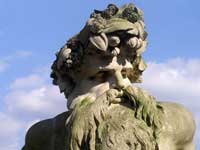
|
|

John Bacon (November 24, 1740 – August 4, 1799) was a British sculptor. Born in Southwark, he was the son of a cloth worker from Somerset. At the age of fourteen he was apprenticed to a manufacturer of porcelain at Lambeth, where he was at first employed in painting the small ornamental pieces of china, but was promoted to modeller. His observation of the models executed by different sculptors of eminence, which were sent to be fired at an adjoining pottery, determined the direction of his genius; he imitated them with so much success that in 1758 a small figure of Peace sent by him to the Society for the Encouragement of Arts received a prize, and the highest premiums given by that society were adjudged to him nine times between the years 1763 and 1776. During his apprenticeship he also improved the method of working statues in artificial stone, by 1769 working for the Coade Artificial Stone Manufactory, an art which he afterwards carried to perfection. Bacon first attempted working in marble in about 1763, and during the course of his early efforts in this art was led to improve the method of transferring the form of the model to the marble (technically "getting out the points") by the invention of a more perfect instrument for the purpose. This instrument possessed many advantages; it was more exact, took a correct measurement in every direction, was contained in a small compass, and could be used on either the model or the marble. In 1769 he was awarded the first gold medal for sculpture given by the Royal Academy, for a bas-relief representing the escape of Aeneas from Troy. In 1770 he exhibited a figure of Mars, which gained him the gold medal of the Society of Arts and his election as A.R.A. As a consequence of this success he was engaged to execute a bust of King George III, intended for Christ Church, Oxford. He retained the king's favour throughout life, though he was commonly criticised for ignorance of classic style. This charge he refuted with a noble head of Jupiter Tonans, and many of his emblematical figures are in perfect classical taste. He died on August 4, 1799 and was buried in Whitfield's Tabernacle. After his death, Bacon's practice was carried on by his son John Bacon, Jnr (1777–1859). His various productions which may be studied in St Paul's Cathedral, London, Christ Church and Pembroke College, Oxford, Bath Abbey and Bristol cathedral, give ample testimony to Bacon's powers. Perhaps his best works are to be found among the monuments in Westminster Abbey.
* Chisholm, Hugh, ed (1911). "Bacon, John". Encyclopædia Britannica (Eleventh ed.). Cambridge University Press. which in turn cites: Retrieved from "http://en.wikipedia.org/ ", Text is available under the Creative Commons Attribution-ShareAlike License |
==++==++== |